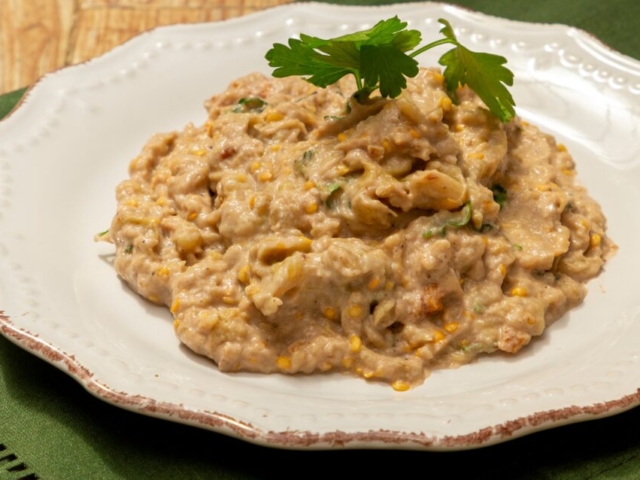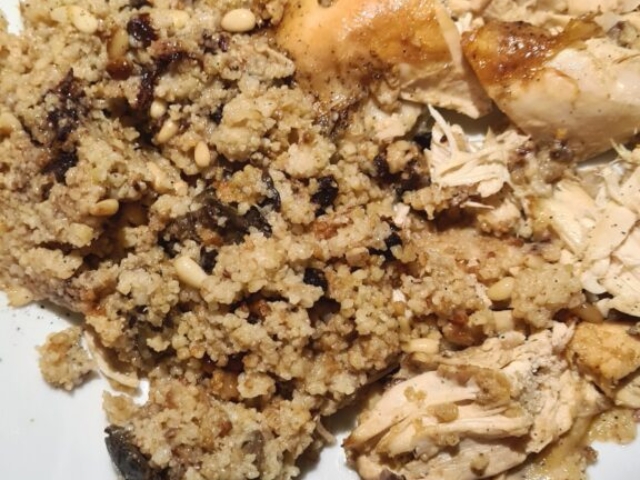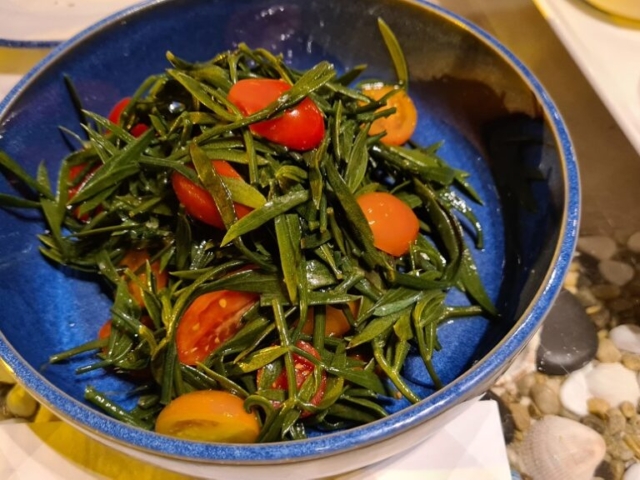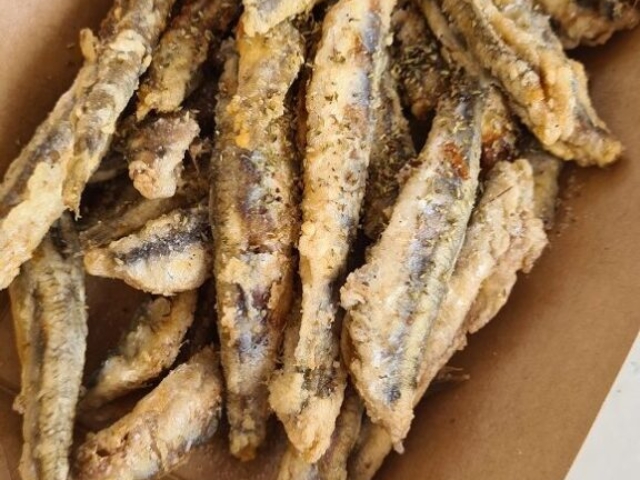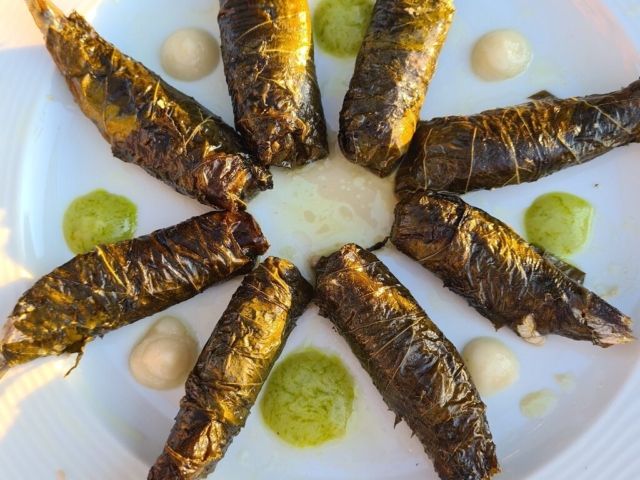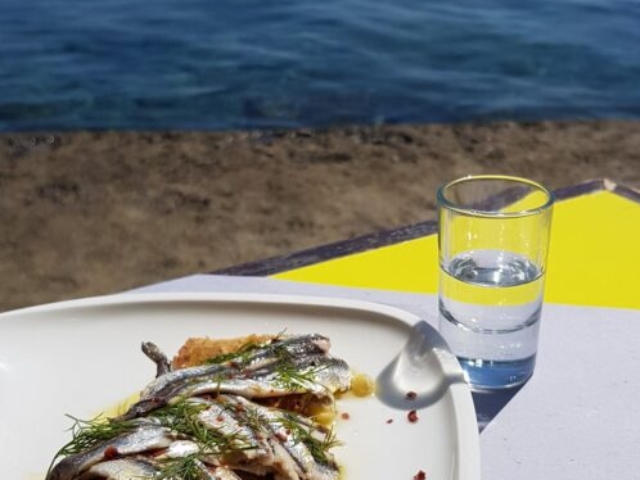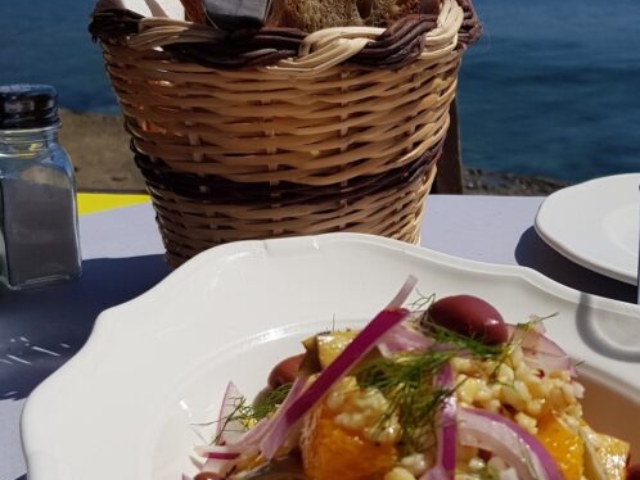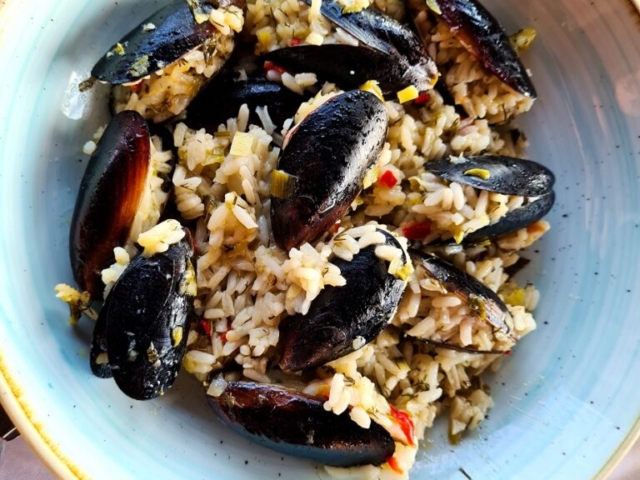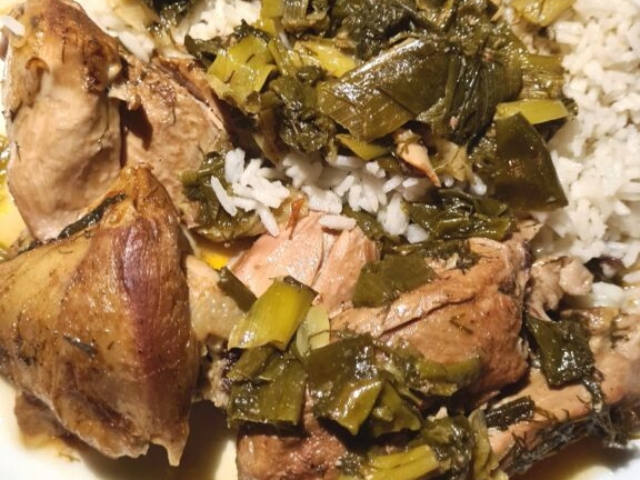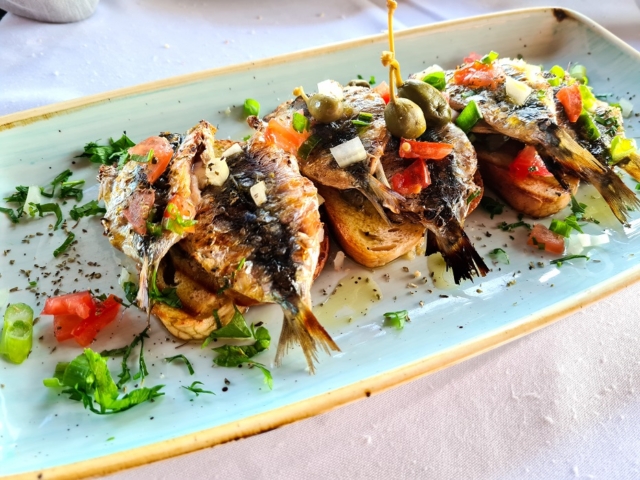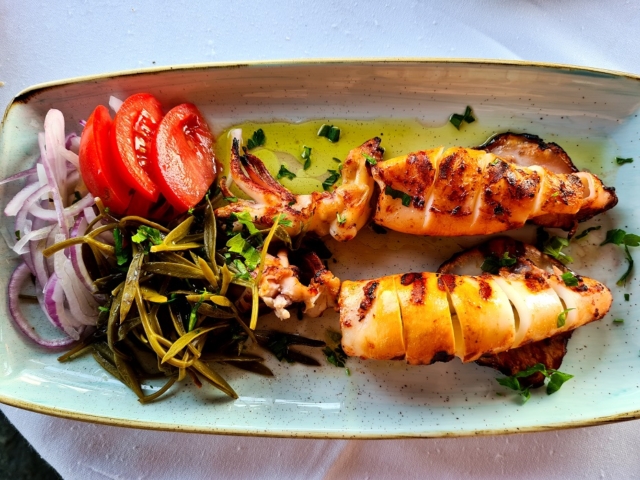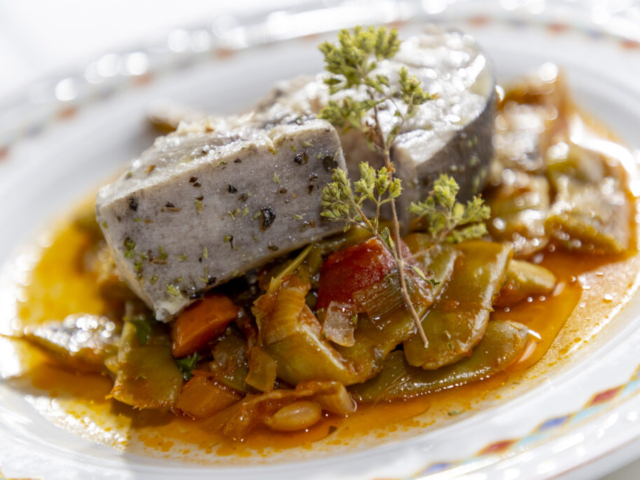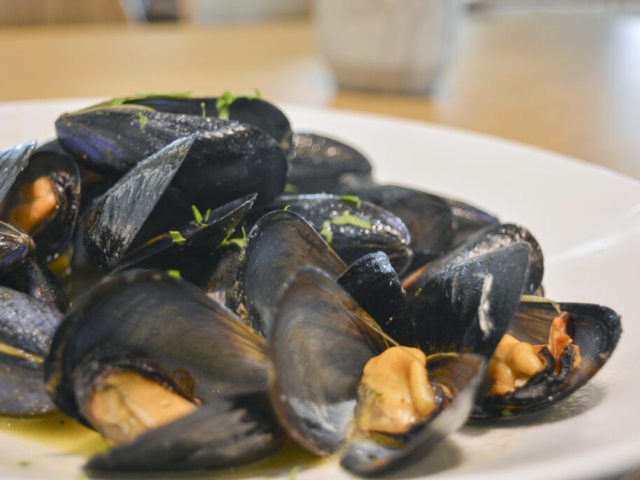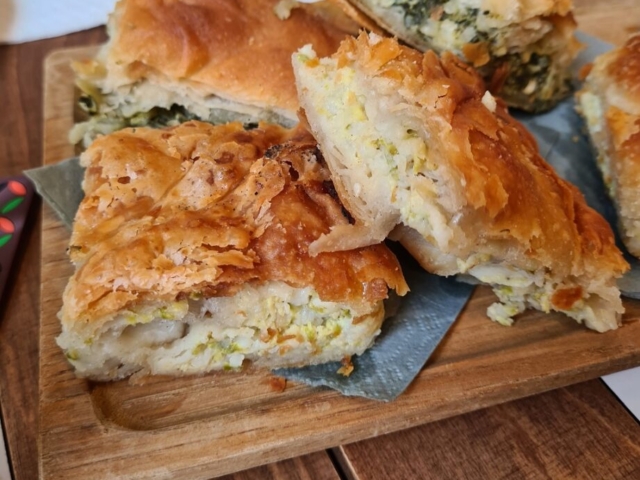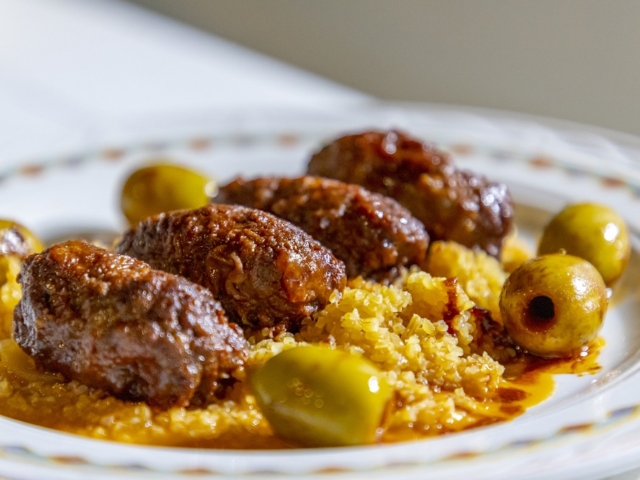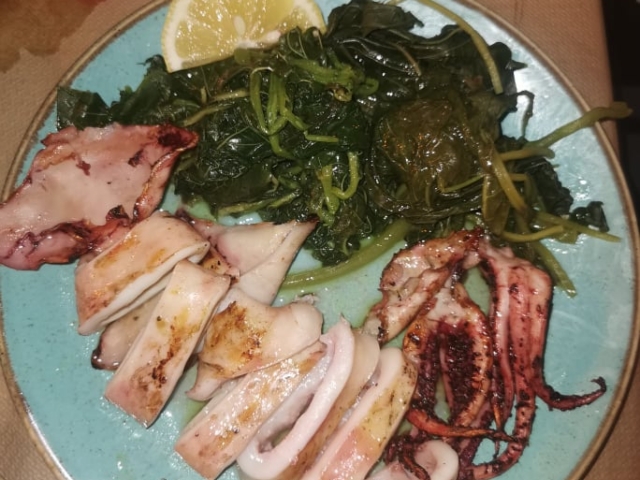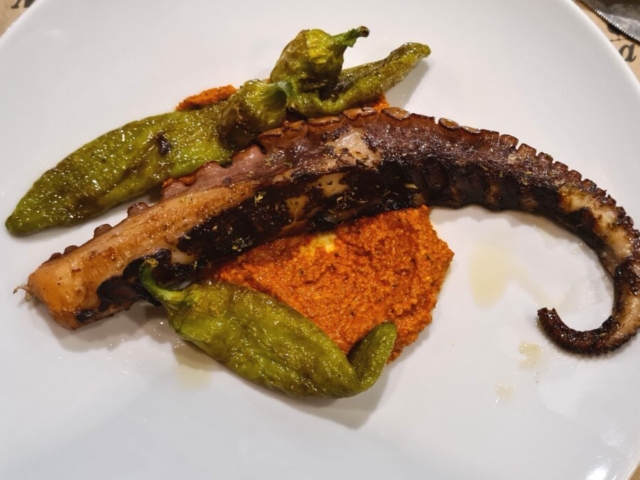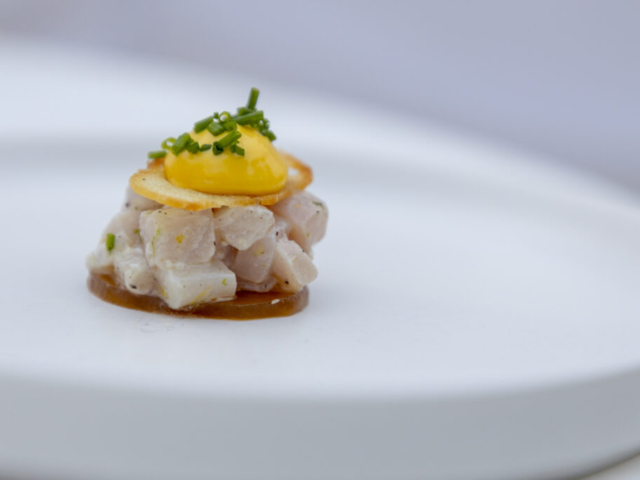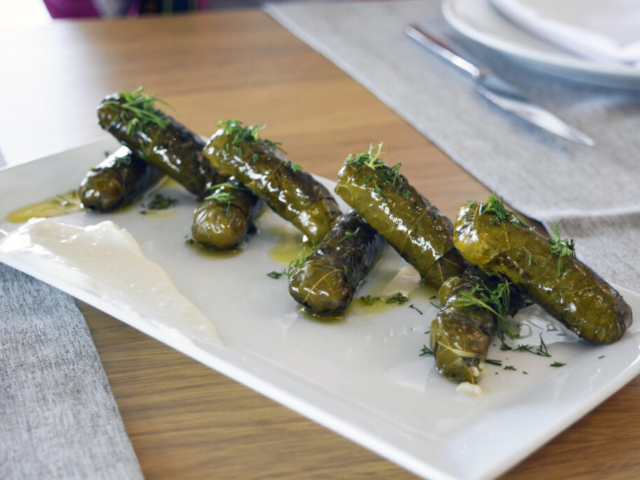RECIPES
Aubergine Salad from Agio Oros
If the aubergines are nicely smoked the authentic taste becomes even better.
We need: 1 kg fat aubergines • 3-4 cloves garlic • 150gr olive oil • 200gr graded nuts • parsley finely chopped • coarse sea salt • vinegar
Instructions: Ideally we grill the aubergines on coals in order to take the smoke we wish to. If not possible, we grill them in the oven until they become tender and black all around. We peel them, and we bring them with a spoon in a bowl. We add the olive oil, the parsley, the vinegar and finally the graded nuts and mix well all the ingredients togehter.

Kolobaropita salty (special local pie)
Traditional local pie recipe with courgette made without pastry sheet. It’s name comes from the word “kolobaros” which means naked in the local dialect.
We need: 1 kg courgettes • 2 teacups bread crumbs • 4-5 spring onions • 1 teacup dill finely chopped • 1 teaspoon spearmint finely chopped • 250 gr feta cheese • 2 eggs • 1/2 teacup olive oil • salt & pepper finely grated
Instructions: We peel the courgettes and grate them. We season them with coarse salt and leave them for a while in a strainer to extract the water. We whip the eggs, add the feta cheese, that we have cut into bigger pieces with our fingers, until they mix together. We press the courgettes with our hands to extract the excess water and mix them with the other ingredients. We sprinkle first the olive oil in a baking pan and then the half of the bread crumbs until it becomes an even layer. We pour the mixture and then the rest of the bread crumbs and the oil. We bake in a preheated oven at 170°C for about an hour, until it becomes brown. We set aside until it cool a bit down and then serve.

Paspalas
A special “meze” from pork cooked in its own lard. They used to keep it so for many months and added small pieces of the meat in other dishes, such as legumes or vegetables in order to add flavor.
We need: 1 kg pork meat (from the neck) • 2 traditional sausages • lard (pork fat)
Instructions: We cut the meat in small pieces and bring it to boil until it becomes tender. We fry it in the lard with the sausages seasoning with salt. We put in a clay pot, cover it with the fat and close with the lid. We serve it either warm or cold.

Trahana pie
The so called “bobota” in many places, is a perfect snack that you cannot stop eating!
We need:400gr. feta or goat cheese • 300gr sweet trahana • 200gr crushed rusk • 3 eggs • 3 spoons butter • 2 glasses water • chopped spearmint
Instructions:We pour the water in a pot and bring it to boil. We add trahana and stir. We pour the milk afterwards and wait until it starts to boil. We leave it for 5′ to rest until it absorbs all the water. We beat the eggs, pour them in the trahana with the butter and stir. We close the lid and leave it to rest. We sprinkle with oil a baking tray and afterwards with the crushed rusk. We pour the mixture with the trahana and scrub in big pieces the rest the cheese. We bake in preheated oven at 200°C until it becomes golden brown.

Young goat in oven “Psima”
Traditional Easter recipe from Kassandra, that we can easily cook any time of the year.
We need: 1kg young goat • olive oil to spread over it • salt & pepper For the rice we need: 1/4 teacup olive oil • 2 bunches spring onions • 1 dried onion • 1 bunch dill • spearmint finely chopped • 1 teacups long grain rice • salt & pepper
Instructions: We wash thoughroughly the goat, spread olive oil all over it and finally season with salt and pepper. We put the skin under on a big baking pan. We pour 1 glass water and bake in a preheated oven at 200°C. If the water evaporates we pour more water. We chop the spring onions in small pieces, as well as the dried onion, we pour olive oil in a saucepan and start browning the onions. We put the rice and continue until it becomes transparent. We season with salt and pepper and remove from the fire. We add the dill and the finely chopped spearmint. We turn the meat upside down, add the rice around and pour 4 glasses of hot water. We continue baking until the rice absorbs the water and the goat becomes golden brown.

Grouper with green beans in a big pan
From the rocky areas in the deep blue sea in a big pan with fresh, green beans, tomatos, parsley and a lot of olive oil.
We need: 1 kg grouper cut into slices • 1kg fresh green beans washed and peeled • 250g tomatoes grated • 2-3 onions finely chopped • 3-4 cloves garlic • 250g olive oil • 1 bunch parsley finely chopped • paprika • salt & pepper
Instructions: We wash the fish, season it with a lot of coarse sea salt and leave it in a strainer to extract the excess water. In a wide saucepan we pour the olive oil, put the fish with garlic and brown it from each side for about 1-2′. We take out the fish with a perforated spoon and leave it in a plate. In the same oil we put the onions and brown them for a while. We add the green beans and continue. We add the tomatoes, salt, pepper, paprika and pour extra hot water to cover them. We cook for about 30-35′ or until they become as tender as we wish. We open the saucepan, sprinkle the parsley, the fish with its juices and shake the saucepan. We leave it until it starts to oil, remove from fire and leave it covered for 5-10′.

Mussels from Olympiada steam cooked
The delicious Olympiada mussels will open during frying and will extract the sea aromas.
We need : 1 kg mussels with their shells • 3-4 garlic cloves finely chopped • 100gr olive oil • 1/2 bunch dill • juice from 4 lemons
Instructions: We wash the mussels thoroughly, scratch them with a brush and remove the hairy covering. We put the mussels in a saucepan and pour the olive oil over them, the garlic, the dill and half of the lemon juice. The mussels will extract their own water. We leave them on the heat for about 15′ until they all open. We transfer them in a big bowl, pour the rest of the lemon juice and serve.

Courgettes in the oven with red pepper
The pour courgettes will become a tasteful dish that you may eat either plain with joghurt and fresh bread or as a side dish to meat or fish.
We need : 3 big courgettes • olive oil • spearmint • salt • ground red pepper
Instructions : We cut the courgettes in thin slices, we salt them and put them on a baking tray after we have cover it with baking paper. We pour the olive oil, season with red pepper and bake at 200°C for 25-30′. When we take the tray out of the oven we sprinkle the thin chopped spearmint. We may use dried spearmint if we don’t have fresh one.

Kalamari with greens
The sea and the mountain meet in a dish that you can enjoy any time of the year even during fasting.
We need: 1 kg kalamari • 3-4 dried onions • 3-4 cloves garlic • 200gr olive oil • 2 leeks • 1-1,5 kg greens • 1 bunch spring onions • 1 bunch fennel • 5 lemons • salt & pepper
Instructions: We clean the kalamari from its ink, membrane, etc and wash them well,. We boil them with a little water for half an hour and keep the water. We cut them in small pieces 2-3cm. each. We wash the greens thoroughly and cut them into pieces 5-6cm. We brown the onions with the leeks, cut into small pieces. We add the greens, the garlic and stir. When the greens have dried we pour a glass hot water and 2 spoonfuls from the kalamari water. We season with salt and cover with the lid. We boil in high heat for about 30′. We add the kalamari, pepper, low the heat and leave to boil until it absorbs the water. We pour the lemon juice and remove from the fire.

Stuffed vine leaves with rice
The “fake” dolma (stuffed) that brought the Greeks from Constantinople and their lost homelands, is a perfect fasting dish but also a tasteful “meze” as a starter for the ouzo or tsipouro.
We need: 1/2 kg vine leaves fresh or canned • 2 bunches spring onions • 2 big dried onions • 1 bunch dill • 1 bunch parsley • 2 tea cups rice • 1 tea cup olive oil • juice from 1 lemon • salt & pepper
Instruction : We mix all the ingredients together for the filling. We put the vine leaves on a tray. We put a tea spoon of the filling in every vine leave and wrap it around in order make a well-formed dolmadaki. We put them in a put one next to the other in layers. When the wrapping is over we pour the olive oil, the lemon, salt, pepper and pour water almost to the top of the pot. We place a soup plate over them, close the lid and boil in low heat for about 45′.
Μουντοβίνα
Ένα προϊόν, αποκλειστικά της ορεινής Χαλκιδικής, είναι η Μουντοβίνα ή το τσίπουρο των μελισσοκόμων. Θα το βρείτε κυρίως στην Αρναία. Πρόκειται για τσίπουρο από το αγνό μέλι της περιοχής, γλυκόπιοτο με γεμάτη γεύση. Παρασκευάζεται με απόσταξη από νερό μέσα στο οποίο βάζουν τις κερήθρες που έσπασαν κατά το μάζεμα του μελιού. Αφού τρυγήσουν το μέλι από αυτές, ζυμώνουν τα σάκχαρα που απέμειναν και αποστάζουν το ζυμωμένο γλευκόμελο, για να παρασκευάσουν τη μουντοβίνα.
Αγιορείτικη Μελιτζανοσαλάτα
Σίγουρα αυτή η παραλλαγή είναι φημισμένη σε όλη τη Μακεδονία, όμως στη Χαλκιδική θα απολαύσετε την αυθεντική. Και αν η μελιτζάνα είναι καπνιστή, η γεύση απογειώνεται!
Άγρια μανιτάρια
Τα μανιτάρια όλων των ειδών, που φυτρώνουν αθρόα στην ορεινή Χαλκιδική, είναι πεντανόστιμα. Μπορείτε να τα δοκιμάσετε είτε απλά τηγανιτά και ψητά, είτε σε παραλλαγές όπως μανιταρόπιτες, μανιταροκεφτέδες, κ.α.
Κολομπαρόπιτα
Η κολομπαρόπιτα είναι μία παραδοσιακή τοπική συνταγή. Το όνομα της πίτας προέρχεται από τη λέξη “κολόμπαρος”, που στα χαλκιδικιώτικα σημαίνει γυμνός. Κι αυτό γιατί η συγκεκριμένη πίτα δεν έχει φύλλο. Αποτελείται από χυλό με βάση το κολοκυθάκι. Θα τη βρείτε αλμυρή η γλυκιά.
ΚΟΛΟΜΠΑΡΟΠΙΤΑ (ΠΑΣΠΑΛΙΝΑ) ΑΛΜΥΡΗ
Κολομπαρόπιτα[=γυμνή πίτα, χωρίς φύλλο]
Πασπαλίνα[=το εξωτερικό της προέρχεται από πασπάλισμα]
Υλικά
• 2 φλ. του τσαγιού τριμμένη φρυγανιά
• 1 κιλό κολοκυθάκια,
• 4-5 φρέσκα κρεμμυδάκια,
• 1 φλ. ψιλοκομμένο άνηθο,
• 1 κ.τ.γλ δυόσμο ψιλοκομμένο,
• 250 γρ φέτα,
• 2 αβγά,
• 1/2 φλ. του τσαγιού ελαιόλαδο παρθένο έξτρα,
• πιπέρι μαύρο φρεσκοτριμμένο,
• αλάτι
Προετοιμασία
Καθαρίζουμε τα κολοκυθάκια, και τα τρίβουμε στον τρίφτη.
Τα πασπαλίζουμε με λίγο χοντρό αλάτι και τα αφήνουμε σε ένα τρυπητό για τουλάχιστον μία ώρα, να αποβάλουν τα υγρά τους.
Χτυπάμε ελαφρά τα αβγά, προσθέτουμε τη φέτα χοντροκομμένη με τα δάχτυλα, και ανακατεύουμε να γίνει το μίγμα ομοιογενές. Προσθέτουμε το στυμμένο κολοκύθι κι όλα τα υπόλοιπα υλικά.
Λαδώνουμε ένα ταψάκι ή πυρέξ. Ρίχνουμε από κάτω λάδι και ένα φλυτζάνι φρυγανιάς προσέχοντας να σχηματίσει ένα ομοιόμορφο στρώμα. Στρώνουμε από πάνω το μίγμα με τα κολοκυθάκια. Τέλος, σκορπίζουμε από πάνω την υπόλοιπη φρυγανιά και το λάδι.
Ψήνουμε σε προθερμασμένο φούρνο, στους 170°C, για περίπου μια ώρα, μέχρι να ροδίσει.
Tip :
Αφήνουμε την πίτα να κρυώσει λίγο, για να μπορέσουμε να την σερβίρουμε χωρίς να διαλυθεί.
Πασπαλάς
Ένας «βαρβάτος» μεζές με χοιρινό κρέας να μαγειρεύεται μέσα στο λίπος του. Με αυτόν τον τρόπο όμως στη Χαλκιδική, όπως και σε άλλες περιοχές της Ελλάδας, διατηρούσαν στο παρελθόν το κρέας για αρκετούς μήνες. Έπαιρναν κομματάκια και τα πρόσθεταν για νοστιμιά σε διάφορα φαγητά με όσπρια ή λαχανικά.
Κοτόπουλο με τραχανά
Στη Χαλκιδική ο τραχανάς έχει την τιμητική του. Μαγειρεύεται με πολλούς τρόπους, όπως ως τραχανόπιτα, το καθιερωμένο τοπικό πιάτο όμως είναι η σούπα κοτόπουλο με τραχανά, ένας συνδυασμός νοστιμότατος και …θρεπτικός.
Κατσικάκι «Ψήμα» στον φούρνο
Είναι μια παραδοσιακή συνταγή καθιερωμένη ως πασχαλιάτικη. Τη μαγειρεύουν όμως όλο τον χρόνο, οπότε εάν τη βρείτε στο μενού κάποιου εστιατορίου, μην διστάσετε να τη δοκιμάσετε. Είναι κατσικάκι σιγοψημένο στον φούρνο μαζί με χυλωμένο ρύζι με μπόλικα φρέσκα κρεμμυδάκια. Το γευστικό αποτέλεσμα είναι μοναδικό.
Αγιορείτικος Μπακαλιάρος
Ένα ιδιαίτερο πιάτο από την κουζίνα του Άθω στο οποίο ο παστός ξαλμυρισμένος μπακαλιάρος μαγειρεύεται γιαχνί με πατάτες, κρεμμύδια και δαμάσκηνα.
ΠΙΤΕΣ
Πίτα με άγρια χόρτα και σπανάκι (χορτόπιτα)
Πίτα με τραχανό κατσικίσιο (τραχανόπιτα)
Λουκάνικο χοιρινό με πορτοκάλι και πράσο
Ντολμαδάκια γιαλαντζή
Κοτόπουλο γεμιστό με τραχανά
Κατσικάκι Κασσανδρινό Πασχαλινό (άνηθο, φρέσκα κρεμμύδια,ξινά δαμάσκηνα και ρύζι)
ΚΟΛΟΚΥΘΙ ΜΕ ΤΟΥΝΑ
[θεωρούνταν το επίσημο φαγητό της οικογένειας και μαγειρευόταν για καλεσμένους ή σε γιορτές]
Υλικά
• Τέσσερις μεγάλες φέτες ψαριού
• 5-6 κολοκυθάκια μέτρια
• 2 πατάτες
• 3-4 φρέσκα κρεμμυδάκια
• 1 ξερό κρεμμύδι
• Άνηθος
• Λάδι-αλάτι- πιπέρι-ξινό
Εκτέλεση
Σε μια πλατιά κατσαρόλα (νταβά) στρώνουμε στον πάτο την πατάτα, κομμένη σε φέτες και μετά τα κολοκυθάκια κομμένα σε φέτες κατά μήκος, αν είναι μικρά, στρογγυλές αν είναι μεγάλα, στη συνέχεια το ξερό κρεμμύδι, κομμένο σε ροδέλες και τα φρέσκα κρεμμυδάκια ψιλοκομμένα.
Στρώνουμε από πάνω τις φέτες του ψαριού και προσθέτουμε νερό (σχεδόν πρέπει να τα σκεπάζει).
Βάζω την κατσαρόλα στη φωτιά και ξαφρίζω [=βγάζω τον αφρό που παράγεται από το βράσιμο].
Αφού απομακρυνθεί τελείως ο αφρός βρασμού, προσθέτω λάδι και αλάτι και αφήνω να βράσει καλά το φαγητό, χαμηλώνοντας τη φωτιά, μέχρι να ρουφήξει όλο το νερό και να μείνει λίγο ζουμάκι.
Προσθέτω, αφού σβήσω τη φωτιά, μία κουταλιά ξινό και το ανακατεύω για να «δέσει» το ζουμί, ενώ στο τέλος ρίχνω τον άνηθο και το πιπέρι.
Tips:
• Το ψάρι μπορεί να είναι επίσης ροφός, μαγιάτικο, και άλλο ψάρι φέτα ή μπακαλιάρος.
• Mπορούμε να προσθέσουμε μία σκελίδα σκόρδο-αν το άρωμα μας αρέσει.
Το σκόρδο δένει ωραία το ζουμί και το ασπρίζει.
• Το ψάρι είναι καλό να μαγειρεύεται σε φλόγιστρο, παρά στο μάτι της κουζίνας- πραγματικά η φωτιά του δίνει γεύση!
ΚΟΛΟΚΥΘΑΚΙΑ ΣΤΟ ΦΟΥΡΝΟ ΜΕ ΚΟΚΚΙΝΟ ΠΙΠΕΡΙ
Υλικά
Τρία μεγάλα κολοκυθάκια
Αλάτι-λάδι-κόκκινο πιπέρι
Δυόσμος
Εκτέλεση
Κόβουμε τα κολοκυθάκια σε λεπτές φέτες, τα αλατίζουμε καλά και αραδιάζουμε σε ένα ταψί, στρωμένο με λαδόκολλα.
Περιχύνουμε λίγο λάδι, πασπαλίζουμε με κόκκινο πιπέρι και ψήνουμε για 25-30 λεπτά.
Μόλις βγάλουμε το ταψί από το φούρνο, ρίχνουμε ψιλοκομμένο δυόσμο ή, εναλλακτικά, ξερό.
Tips :
*συνοδεύονται πολύ ωραία με στραγγιστό γιαούρτι. *Επίσης μπορούν να συνοδέψουν ψητά κρέατα-ψάρια-κοτόπουλο
*Μπορούμε να τα αλευρώσουμε, ώστε να γίνουν πιο τραγανά (αλλά και πιο βαριά…)

The Chamber of Halkidiki has launched a series of events, under the program “Agricultural Development of Greece 2014-2020 CLLD LEADER” in order to promote the gastronomy of Halkidiki.


